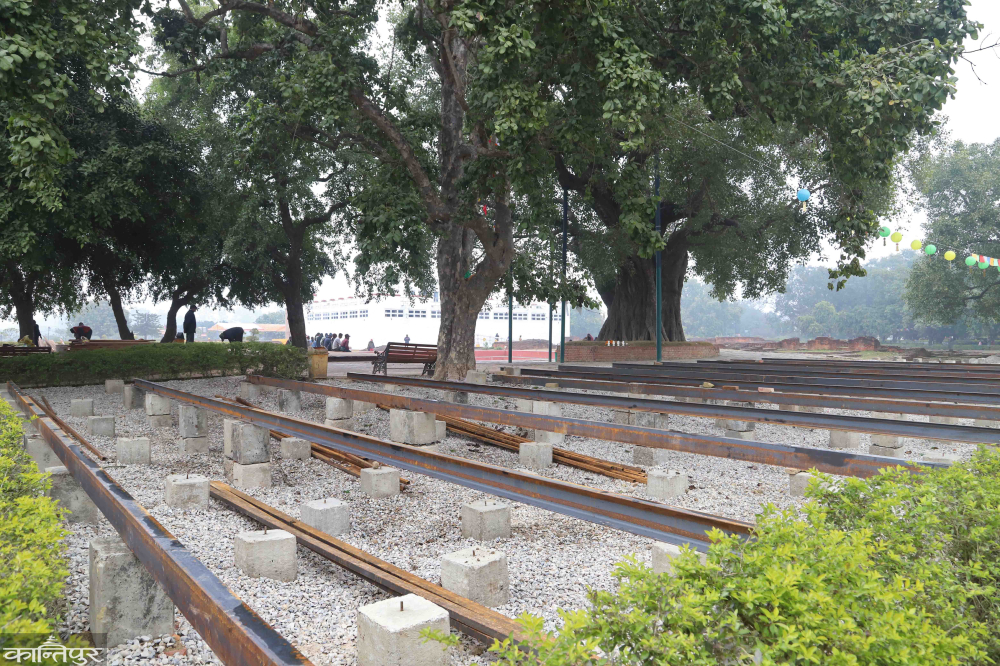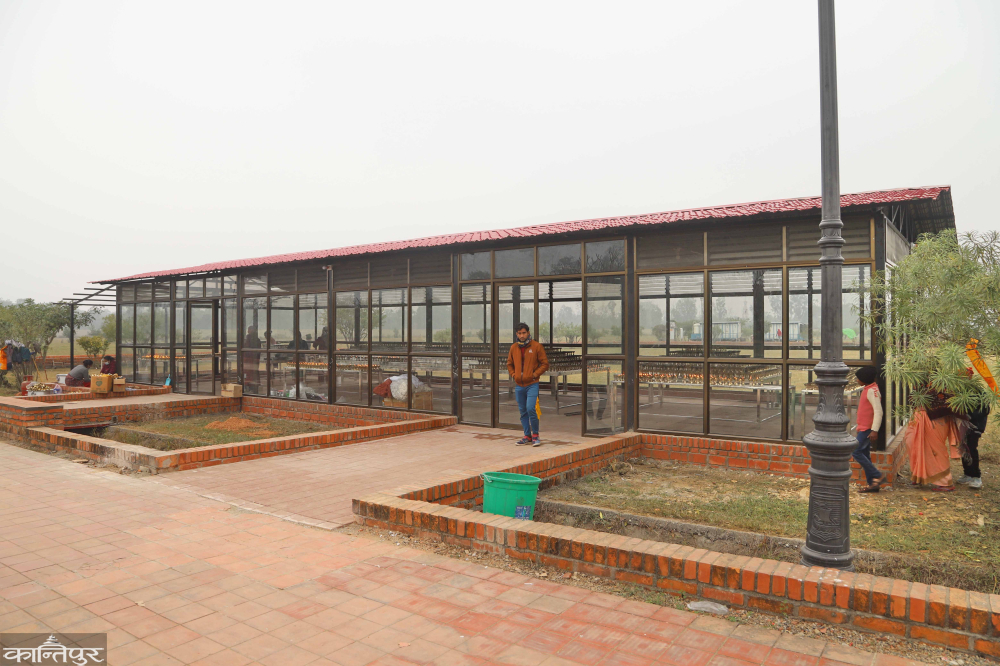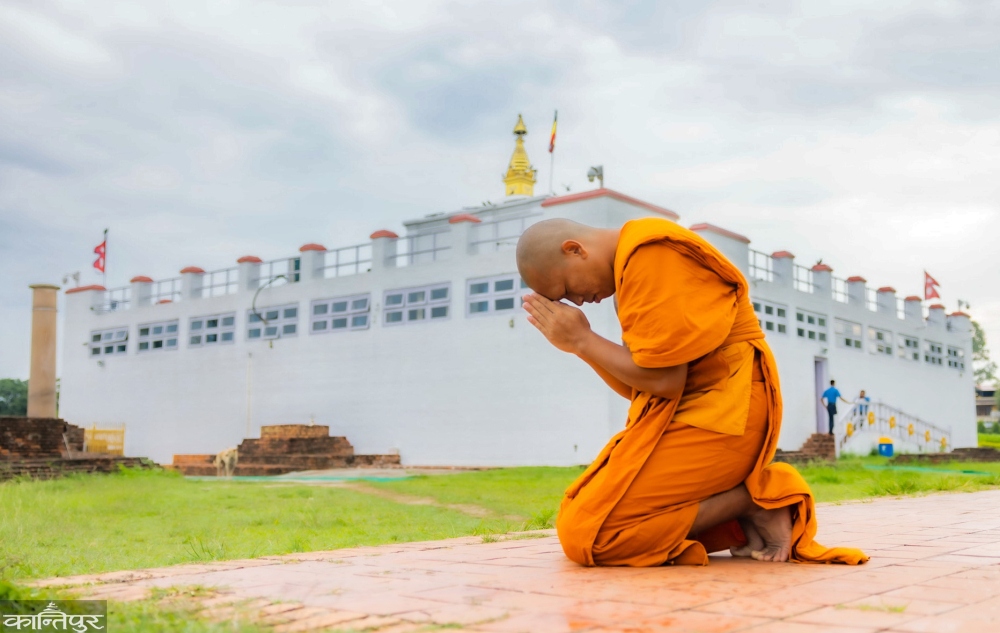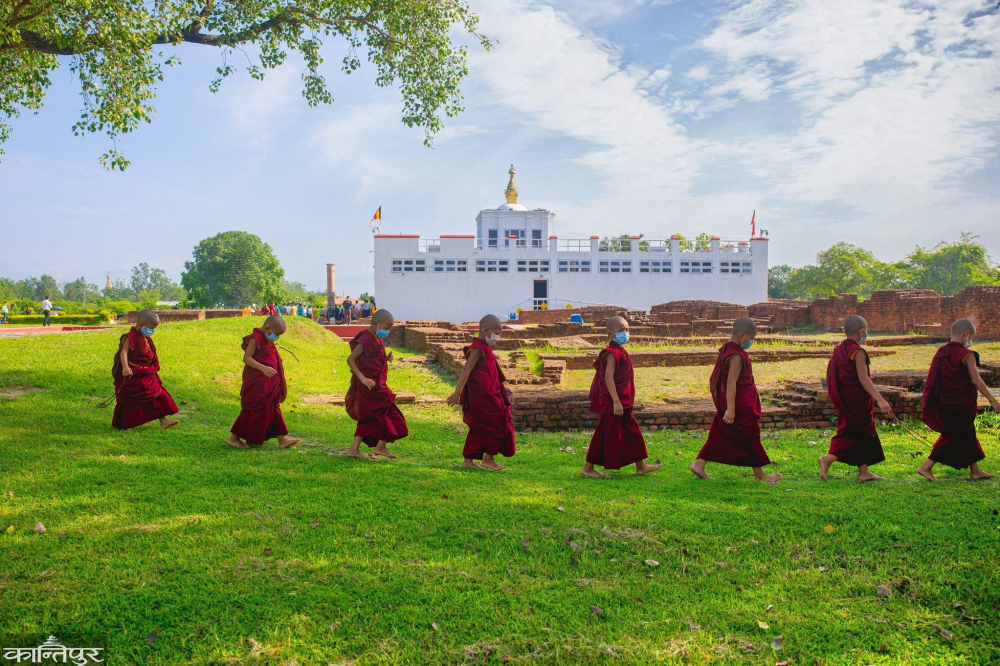Lumbini risk not averted

We use Google Cloud Translation Services. Google requires we provide the following disclaimer relating to use of this service:
This service may contain translations powered by Google. Google disclaims all warranties related to the translations, expressed or implied, including any warranties of accuracy, reliability, and any implied warranties of merchantability, fitness for a particular purpose, and noninfringement.

Highlights
- The UNESCO World Heritage Committee sent 12 directive points and gave a deadline to submit SOP (State of Conservation Report) on the work being done under the Master Plan before 1 February 2025.
- Under the master plan, there are sacred gardens, international Buddhist vihara area and new Lumbini village, there is still a lot of work to be done in Lumbini village and there is still a lot of work to be done including the reconstruction of the auditorium hall, construction and distribution of water tower.



There was a high risk that the UNESCO World Heritage Committee would put Lumbini, the birthplace of Buddha, on the endangered list after activities contrary to the Lumbini Development Master Plan and non-heritage-friendly construction work.

However, Nepal got some relief after the 46th session of the committee held in New Delhi, the capital of India, from July 6 to 16, decided not to put it on the threat list for the time being. However, the said decision did not decide to keep the Buddha's birth place on the list of danger forever. Instead, a 6-month 'dateline' has been given for the improvement of what made Lumbini in the risk list.
Indicating this danger, Himal Upreti, Head of Archeology Branch of Lumbini Development Fund, said in his Facebook status, 'Friends, let's not clap now. Let us help from our respective positions for the proper management of the challenges that may come now.' He cautioned the stakeholders that the danger of Lumbini, the birthplace of Buddha, being listed as a world heritage site has not gone away, but rather the challenges have increased. If the weakness is not corrected within the next 5 months, the risk of being listed as a threat in the coming year has not been eliminated. Even if such a threat is removed only for one year, the employees of the fund themselves say that the risk is still the same. UNESCO has drafted Lumbini to be listed as endangered in 2024.
In the discussion about Lumbini, the UNESCO World Heritage Committee has sent 12 points of instructions covering the proposals made by Nepal, issues raised, queries and suggestions received. Only 5 months are left to work on UNESCO's concerns, directives. The deadline has been given to submit SOP (State of Conservation Report) on the work done by them before February 1, 2025. The 47th session of UNESCO is taking place in July 2025 in Bulgaria. Upreti, the senior archeological officer of the fund, said that Lumbini should not be allowed to fall into the danger list by helping everyone from their place. For this, he said, it is inevitable to work by making a conservation-friendly and action plan from today.
'The report submitted by the Reactive Monitoring Mission to UNESCO in 2022 and the decision of the 45th session of the UNESCO World Heritage Committee held in Riyadh in 2023 to request a SOP (State of Conservation Report) from Nepal raised some issues,' Upreti added, 'Similarly. The draft decision to put it in the danger list was made based on the matter.'' Fund member secretary Sanuraja Shakya said that work is being done to prevent Lumbini from falling into danger by doing a lot of work in a short time. "We are working intensively for this," he said The challenge is getting worse. The situation is worsening due to the lack of coordination among the leaders and lack of communication with the local stakeholders. Heritage experts say that instead of protecting the heritage in Lumbini, unnecessary infrastructure is being added in the name of modernity and beauty. In the 46th session of UNESCO, when there was a discussion on why Lumbini should not be included in the endangered list, India proposed an amendment. Due to this proposal, Lumbini has been spared from being on the immediate danger list. However, senior director of Lumbini Development Fund, Gyanin Rai, said that efforts for improvement and conservation have been started by focusing on the points sent by UNESCO. "There is a lot of work to be done, the cooperation of all three levels of government, experts and stakeholders is indispensable," he said. Rai said that only this will secure the future of Lumbini.
UNESCO raised questions on 8 issues. The government has instructed to speedily implement the integrated management framework (Integrated Management Framework) approved for the protection and management of Lumbini's heritage. The integrated management structure covers tourist/pilgrim services, disaster management, community and pilgrimage. There are guidelines to guarantee the preservation of the main structures of Lumbini, the Ashoka Pillar, the 'Nativity Sculptures', the Birth Monument Shila (Marker Stone) and the archaeological remains within the Mayadevi Temple. It has been requested to be clear on how to coordinate and participate in heritage conservation between the local, state and federal governments.

UNESCO has instructed to make a plan and work so that the cultural heritage is not affected during the religious activities and festivals that have been going on since ancient times. Similarly, it is said to make a sector strategy (fragmented strategy). Similarly, the environment, visitor management, conservation plan, development of sacred gardens and natural disaster strategy have been instructed. Before preparing the fragmented strategy and implementing it, it has been instructed to take advice and suggestions from the advisory committee of the UNESCO World Heritage Committee and finalize it. In the fourth point, the World Heritage Center and ECOMUS sent a reactive monitoring mission to Lumbini in 2022 involving heritage expert Rolen Lin and Professor Karia, and expressed dissatisfaction that despite asking for some work recommendations and documents, nothing much was done. The
mission asked for the implementation plan of integrated management structure, site manager Lumbini Development Fund capacity development, formation of world heritage unit within the fund, as some things of world heritage are not mentioned in the Lumbini Development Fund Act. The problem of water seepage inside the Mayadevi temple and its effect on the archaeological ruins was raised about the lack of assurance of safety. Demanding to make a solid plan for this, the mission has also raised questions about the future plans and programs for the protection of Lumbini.
There is not enough space for pilgrims inside the temple. It was better to name the Lumbini Development Fund as the Lumbini Conservation and Development Council and raised questions about the fact that the development was done without assessing the heritage impact. It was suggested that the world heritage site should be made color friendly and that the boats plying on the Central Canal should be free from noise pollution. It has been mentioned that the UNESCO session has also given strict instructions to implement these suggestions to the state side earlier. Based on the report submitted by the reactive monitoring mission to UNESCO, it was decided to put it on the list of danger in 2024. The
mission had already said that in 2022 Lumbini would be on the danger list if these things were not improved. How has the Mayadevi temple been rebuilt before? What materials have been used there? What planning is being done to solve the problem of water leakage and water seepage from below in Mayadevi temple? A team was asked to find out whether the water and the environment are affecting the archeological structures inside the temple. UNESCO has also suggested that the recommendations of the 2023 International Scientific Committee (ISC) meeting should be implemented. It has been instructed to remove the lotus flower placed on the marker stone, to make a visitor management plan and not to do any work other than the approved master plan.

The government should approve the format and guidelines of the HIA for the entire country and send it to make it more organized and strong, UNESCO has instructed to make and send guidelines for the operation of the 5,000 capacity international meditation center and assembly hall built in Lumbini. UNESCO has objected to the structures built around the Mayadevi temple by HIA. A shed has been constructed for meditation/prayer inside the temple, a large path outside the temple and a structure for lighting the island. According to the instructions given by the session, the work has already started, said Rai, the senior director of the fund. The Integrated Management Framework has been approved and implemented and is in the final stage of becoming a segmented strategy. He said that a hydrological report on the effect of water leakage on the Mayadevi temple has been prepared and sent, and after discussing the detailed plan and schedule for the implementation of the recommendations made by the reactive monitoring mission in 2022 and the recommendations made by the ISC meeting in 2023, it has been finalized and sent. Similarly, the lotus flower-shaped shell placed inside the temple to cover the birth memorial stone has been removed after UNESCO asked to remove it.
A lot of effort had to be made to make Lumbini a World Heritage Site. After trying since the time of Lokdarshan Vajracharya, who was the chairman of the Lumbini Development Committee for 10 years from 032, it was listed as a World Heritage Site only in 1997 after the third attempt. Senior archaeologist Vasant Bidari said that it is sad that after 27 years, Lumbini is again in the danger list. He said that such results have come from doing things contrary to the guidelines of UNESCO. "From the beginning, UNESCO was raising questions about the activities going on here," he said.
Fund staff say the activism of Fund Vice President Lyharkyal Lama helped UNESCO back down from its decision to put Lumbini on the endangered list. The Nepali team that reached Delhi met the representatives of the member states with executive powers and lobbied extensively not to include Lumbini in the danger list. Fund Vice President Lama took great initiative politically. Vice President Lama tried to achieve a positive outcome regarding Lumbini by increasing access to Indian Culture Minister Gajendrasinh Sekhawat. By lobbying through India's Foreign Minister S. Jaishankar, he succeeded in making a decision in favor of Lumbini for the time being. Sudhir Bhattarai, UNESCO representative and Nepali Ambassador to France, played an important role in keeping Lumbini from being on the danger list as he took the initiative diplomatically. The Nepalese team met the officials of UNESCO, the representatives of the executive committee member countries separately and discussed.
India's ambassador to UNESCO, Vishal Sharma, who presided over the 46th session of UNESCO, also helped in the matter of Lumbini, so good results have been reported. Nepal was well supported by countries like Japan, Kenya, Rwanda, Vietnam and Qatar. On the Lumbini issue, 19 out of 21 executive member countries supported India's amendment proposal. Lebanon voted to put Lumbini on the danger list. Belgium maintained that India's amendment proposal should not be accepted. The issue of Lumbini was discussed for an hour. The representatives of the executive 21 countries had their own views on Lumbini.

The Lumbini Development Master Plan, which was built in 1978 after 6 years, has not yet been completed. The goal of completing the master plan by 1985 and 17 years by 1995 is still incomplete. 7 billion in 2076, but the officials of the fund said that it will be completed within 3 years, but it has not yet been completed. The work was started by tendering after the government secured the resources of 7 billion. However, after receiving a complaint that the work was not done according to the master plan, the government gave only two billion.
Even though member secretary of Lumbini Development Fund Sanuraja Shakya claims that 88 percent of the master plan has been completed, there is no real basis for it. "If we had the budget, we could have completed the work," he claims, "due to lack of funds, the work is being pushed back." To spread the message of peace and spirituality from the birthplace of Buddha, Japanese architect Prof. Kenzo Tange started making the master plan from 1972 and submitted it to the United Nations in 1978. The United Nations submitted the master plan to the government of Nepal in the same year. The master plan of Tange is divided into 3 areas. There are sacred gardens, international Buddhist temple area and new Lumbini village. A lot of work remains in Lumbini village. Not yet in the works is the magnificent auditorium hall. Water tower construction and distribution work is also left.
6 two-story circular buildings have not been built. Electrification, communication, tarmac and service road works are pending. Drainage and sewage management and pond construction and beautification have not been done. The work of management of 3 rivers/streams flowing through the area where the master plan is implemented is also pending. First aid center, souvenir shop, high school, restaurant, night stay for pilgrims to recite Shanti, meditation (camping place) have not been made either.
The sacred garden is the most important area of Lumbini. It is the southernmost part of the master plan. There is a Mayadevi temple and an Ashoka pillar. There are also Ashoka and Pre-Mauryan brick structures, brick blocks dating back to the Buddha period, cultural elements and ruins of ancient Buddhist temples. According to the master plan, the initial phase of creating 4 ponds, 80 square meters around the world heritage site and green gardens in some small areas has been completed. Between the Sacred Garden and New Lumbini Village is the International Buddhist Vihara area. Here is the world's smallest Buddhist world. To the east of the central canal are the monasteries of the Theravada sect and to the west of the Mahayani sect. To the east are the temples of Sri Lanka, Myanmar, Thailand and Cambodia. To the west, temples of countries including China, Singapore, Japan, Korea, France, Germany, Vietnam and Canada have been built.

 प्रकाशित : भाद्र २२, २०८१ ०७:५५
प्रकाशित : भाद्र २२, २०८१ ०७:५५

 २९.१२°C काठमाडौं
२९.१२°C काठमाडौं














